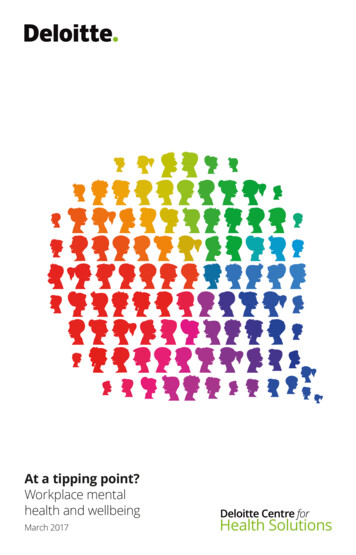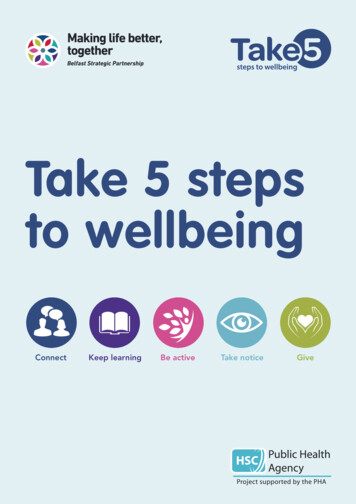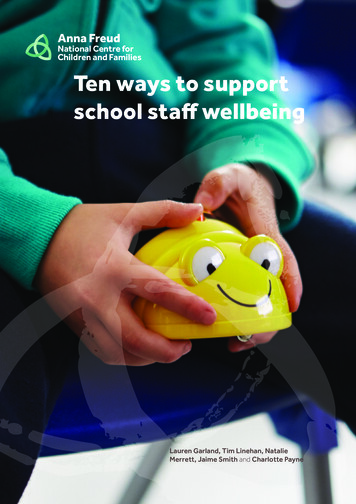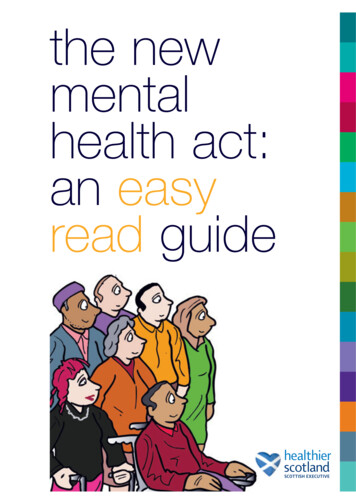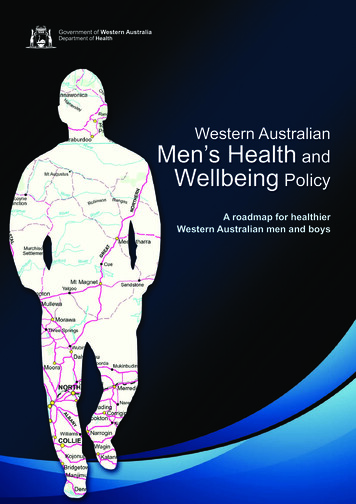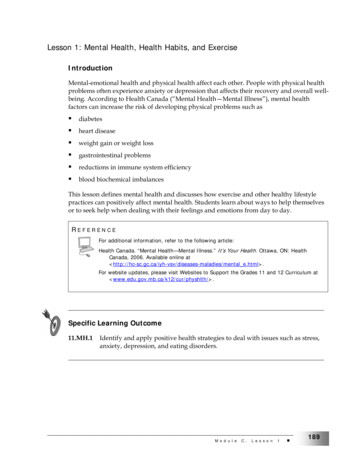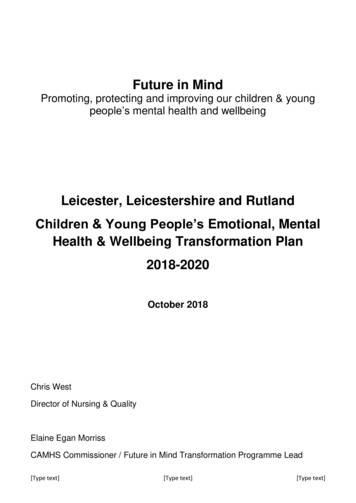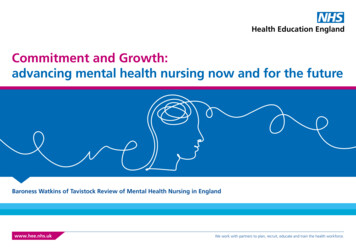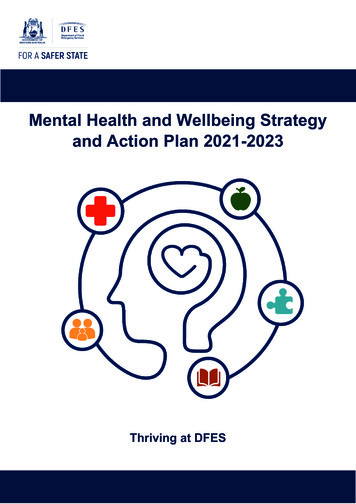
Transcription
Mental Health and Wellbeing Strategyand Action Plan 2021-2023Thriving at DFES
AcknowledgementsAcknowledgement of CountryThe Department of Fire and Emergency Services (DFES) acknowledges theAustralian Aboriginal and Torres Strait Islander peoples of this nation.We acknowledge the Traditional Custodians and we pay our respects to ancestorsand Elders, past and present. DFES is committed to honouring Australian Aboriginaland Torres Strait Islander peoples’ unique cultural and spiritual relationships to theland, waters and their rich contribution to the community.Acknowledgement of our Executive SponsorsThe Thriving at DFES: Mental Health and Wellbeing Strategy and Action Plan 20212023 is actively championed by our three Executive Sponsors:Craig WatersJon BroomhallJohn TillmanDeputy Commissioner OperationsAssistant Commissioner MetropolitanChief Superintendent Bushfire Centre of Excellencewho we thank for their continued support and dedication.Acknowledgement of DFES employees, volunteers1 and key stakeholdersDFES acknowledges the contribution received from our employees, volunteers andkey stakeholders. Your feedback has been invaluable.AccessibilityCopies of this document are available in alternative formats upon request.Contact UsEmail: MentalHealthStrategy@dfes.wa.gov.auPhone: 9395 9300Department of Fire and Emergency ServicesEmergency Services Complex20 Stockton BendCOCKBURN CENTRAL WA 6164 State of Western Australia 2021There is no objection to this publication being copied in whole or part, provided thereis due acknowledgement of any material quoted or reproduced from the publication.1Throughout this document the term ‘volunteer’ is used. Volunteer refers to: Volunteer Fire andRescue Service (VFRS), State Emergency Service (SES), Volunteer Fire and Emergency Service(VFES), Marine Rescue Western Australia (Marine Rescue WA) and the Bushfire Brigade (BFB).Page 2 of 44
Table of ContentsMental Health and Wellbeing Key Messages . 4Every Action Counts . 6The Facts are Clear. 7Key Drivers for Change . 10We Have Listened to Your Feedback . 13What you told us about Workplace Stigma . 13What you told us about Leadership . 13What you told us about Support Services . 14What you told us about Mental Health and Wellbeing . 15Our Vision . 16Our Goal. 17Our Guiding Principles . 17Our Shared Responsibility . 18Our Integrated Approach . 18Our Plan for Action . 21Activity Rationale High-Level Summary . 21Proposed Timeframes . 21Budget Implications . 21Measuring Our Success . 22At a Glance: Current Key Activities to be Maintained . 23At a Glance: Current Key Activities to be Enhanced . 26At a Glance: New Activities . 31Appendix 1. Activity Rationale High-Level Summary . 39Page 3 of 44
Mental Health and Wellbeing Key Messages1.Mental health and wellbeing is more than the absence of mental illnessMental health is “a state of wellbeing in which an individual realises their ownabilities, can cope with the normal stresses of life, can work productively andis able to make a contribution to their community” 2.2.Life is an emotional roller-coasterMental health and wellbeing changes over time in response to our internalfactors (e.g. biological make-up, physical health) and external factors (e.g.social, environmental, cultural, work, exposure to trauma). Combined, thesefactors influence our thoughts, feelings/emotions and behaviours which canaffect both our personal and professional sense of mental health andwellbeing.3.Mental ill-health does not discriminate – it can impact anyoneMental ill-health does not discriminate; it can affect anyone regardless of age,gender, geography, income, social status, race/ethnicity, religion/spirituality,sexual orientation, background or other aspect of cultural identity.Mental ill-health takes many forms and impacts people differently. Someindividuals may experience mild symptoms that only interfere in limited wayswith daily life, while other individuals may experience symptoms so severethat professional support is required.4.There is no room for stigmaStigma discourages help-seeking, makes recovery harder for those who arestruggling, promotes discrimination, and may cause isolation. Stigma oftenarises because of problems of knowledge (ignorance or misinformation),problems of attitude (prejudice), and problems of behaviour (discrimination)3.To take better care of each other, we need to break the stigma associatedwith mental ill-health. By understanding mental health and normalising mentalill-health will we be able to break this cycle.5.Mental health is everyone’s business – it is a shared responsibilityMental ill-health and wellbeing impacts everyone, either directly or indirectly,and therefore everyone has a role to play. It is a shared responsibility. It isimportant to give help and support to others, wherever possible. You don'tneed special training to show someone that you care about them; sometimes,just being there can make all the difference. Familiarising yourself withavailable support services and reaching out is good for everyone.World Health Organization. (2018). ental-healthstrengthening-our-response.3 Beyond Blue. (2020). ated-with-depression-and-anxiety.pdf.2Page 4 of 44
6.Self-care is vital for mental health and wellbeingSelf-care refers to the activities and practices that we purposely choose toengage in on a regular basis to maintain and enhance our mental health andwellbeing. Self-awareness, bringing more balance to your daily routine,regular exercise, healthy balanced diet, sleep hygiene, social connections,sense of purpose and discovering what works will help you be moreproductive and more resilient.7.Social support and connectedness are essentialLevels and quality of personal relationships are protective in nature andpositively enhance mental health and wellbeing, reinforcing the strong rolethat our families/friends/colleagues play in supporting us. Giving andreceiving high levels of social support and maintaining connectedness areassociated with significantly higher levels of personal resilience. Making timeto develop and maintain positive relationships is important for everyone.8.Seeking help is not a failureWhen you are feeling overwhelmed and out of sorts it is not a failure to seekhelp. As the saying goes: a problem shared is a problem halved. Seekinghelp and support for psychological stress and mental ill-health is the same asseeking help and support for physical health. It is not a weakness to feeloverwhelmed. Feeling is part of the human condition and we must not beashamed when we experience challenging emotions. To ensure we obtaintimely and appropriate support when needed, it is important that we challengenotions such as “harden up” or “get over it”.9.Help is always available – you are not aloneThere are a range of support services available to help prevent and/ormitigate psychological stress and mental ill-health. The sooner you reach outand take reasonable steps to address your concerns, the easier it will be torecover. Denying you need help and/or waiting to seek help can have aknock-on effect, leading to secondary problems (e.g. alcohol and other drugdependence, irritability and problems at home). Finding the support pathwaysthat work best for you may take time. The important message here is not togive up. If you need crisis help, support services are available 24/7.10.Together we need to build our practical skills and demonstrate inclusiveand positive behavioursWe need to move beyond raising awareness about mental health andwellbeing to building practical skills and sustainable behaviours that reinforceand promote a mentally healthy workplace and beyond. A collaborativeapproach to mental health and wellbeing is fundamental to the overall healthof our organisation and our people. Integrating lifelong learning to encourage,empower and equip our workforce to be mentally healthy is a priority.Page 5 of 44
Every Action CountsMental ill-health affects all Australians either directly or indirectly. In Australia, it isestimated that 45 per cent of people, or approximately one in two, will experience amental health condition in their lifetime4. Many do not receive the treatment andsupport they need. As a result, too many people experience preventable physicaland psychological distress, disruptions in education and employment, relationshipbreakdowns, stigma, and loss of life satisfaction and opportunities.Action and investment in activities that promote mental health and wellbeing canhelp to improve positive outcomes and reduce the impact on individuals, teams,organisations and communities.Prevention and early intervention actions help reduce harm and the healthconsequences by enabling individuals to be better prepared to seek help and tosupport others.Everyone has a responsibility to build and maintain a mentally healthy workplaceculture – one that is inclusive, rejects stigma and discrimination, and activelysupports recovery. Work and volunteering inevitably shapes our mindsets andbehaviours, which can either help or hinder our performance. When an organisationhas a mentally healthy workplace culture, our wellbeing, sense of purpose, jobsatisfaction and organisational commitment are more likely to be enhanced.A workplace culture that values mental health and wellbeing is good for everyone.4Beyond Blue. (2020). https://www.beyondblue.org.au/the-facts.Page 6 of 44
The Facts are ClearOrganisations have duties under work health and safety laws, to dowhatever is reasonably practicable, to eliminate or minimise risks tothe mental and physical health and wellbeing of their workforce5.Workplace health and safety legislation acknowledges thatemployers and workers have a shared responsibility for their ownhealth and safety6.Mental health conditions result in lost productivity costs of 10.9billion nationally each year7.The average costs of presenteeism (reduced productivity whenworking whilst unwell) far exceeds those attributable to absenteeism.Overall, the average annual cost per employee associated withpresenteeism was estimated at 16808.Mental health issues in the workplace cost the economy 12.8billion each year. Select interventions may be able to save 4.5billion annually9.Almost half (45%) Australians aged between 16-85 will experiencea mental illness in their lifetime10.Occupational Safety and Health Act. (1984).Occupational Safety and Health Act. (1984).7 PwC. (2014). Creating a mentally healthy workplace: Return on investment analysis.8 Safe Work NSW. (2017). Mentally healthy workplaces in NSW: A return on investment study.9 KPMG and Mental Health Australia. (2018). Investing to Save.10 Australian Bureau of Statistics. (2007). National Survey of Mental Health and Wellbeing: Summaryof Results, 4326.0. ABS: Canberra.56Page 7 of 44
Building a mentally healthy workplace can increase attraction of toptalent because such organisations make great places to work12.Thriving workers experience reduced strain and stress, burnout, mentalill-health, substance abuse, and physical ill-health. These individualoutcomes mean organisations have reduced costs associated withabsenteeism, presenteeism and compensation claims11.Mental health and physical health are inextricably linked and peoplewith mental ill-health are more likely to develop physical illness andtend to die earlier than the general population13.A report commissioned by SafeWork NSW has estimated that thereturn on investment for psychological return to work programs is 3.90for small-medium enterprise and 3.74 for large employer per 1 dollarinvested14.Without an integrated approach to workplace mental health andwellbeing any efforts will more likely result in wasted investments andad hoc, disconnected initiatives lacking sustainable change15.Mental ill-health does not discriminate, and that is why prevention andearly intervention strategies are key to improving the mental health andwellbeing of workers16.Nahrgang, J.D., Morgeson F.P., and Hofmann D.A. (2011). Safety at Work: A Meta-AnalyticInvestigation of the Link Between Job Demands, Job Resources, Burnout, Engagement, and SafetyOutcomes. Journal of Applied Psychology. 96(1): pp. 71-94.12 WorkSafe QLD. (2018). Mentally healthy workplaces toolkit.13 Australian Institute of Health and Welfare. (2020). Physical health of people with mental illness.14 SafeWork NSW. (2017). Mentally healthy workplaces in NSW: A return on investment study.15 University of Tasmania. (2018). An integrated approach to workplace mental health: Nine prioritiesfor implementation in Australia.16 NSW State Government. (2017). State Government releases first-ever snapshot of NSW workplacemental health.11Page 8 of 44
Beyond Blue National Mental Health and Wellbeing Study of Police andEmergency ServicesThis study provides a comprehensive picture of the mental health and wellbeing ofpolice and emergency services personnel in Australia.The national survey findings identified that all agencies across all sectors whoparticipated in the survey had common themes of: high numbers of personnel withpsychological distress and probable Post Traumatic Stress Disorder (PTSD); personnelwith mental health conditions not seeking support or receiving adequate support; andstigma negatively impacting support seeking.The Beyond Blue Answering the call National Survey (2018) highlighted that:xOne in three employees experience high or very high psychological distresscompared to just over one in eight among all adults in Australia.xMore than one in 2.5 employees and one in three volunteers report having beendiagnosed with a mental health condition in their life, compared to one in five ofall adults in Australia.xThe workplace environment, particularly team culture and workplace stressfactors (e.g. inadequate resources) have significant impacts on the mental healthof employees.xPoor mental health literacy can lead to people not recognising the need forsupport and not seeking support because they did not know what to do.xEmployees who felt shame or embarrassment about their mental ill-health, andemployees who perceived that their agency was not well equipped to supportpeople with mental health conditions was associated with lower rates of seekingsupport when needed.xEmergency service personnel were identified in the occupations with the highestrate of claims for mental health conditions.In November 2020, Beyond Blue released a National Mental Health and WellbeingStudy of Police and Emergency Services Report Summary.It emphasised the importance of addressing complex issues from multiple angles.“The police and emergency services sector is affected by many of the persistentchallenges experienced more broadly in workplaces, such as bullying, harassment andmental health stigma. In addition to these, some of the complex, challenging issuesraised by agencies throughout included managing exposure risk (trauma), fitness forduty (recruitment, risk of harm to others) and managing members needing respite fromthe operational and psychological impacts of their role. Leading practice approaches toaddressing these challenges examined the issues from multiple angles, knowing that‘the problem’ could not be mitigated without a multi-faceted approach”.Page 9 of 44
Key Drivers for ChangeThere are four key drivers for change that have influenced our Thriving at DFES:Mental Health and Wellbeing Strategy and Action Plan 2021-2023.Driver 1: Beyond Blue Good Practice Framework17 provides first responderagencies with a practical framework to help protect the mental health of theirworkforce, promote wellbeing and prevent suicidality. Key frameworkrecommendations include:xtaking a strategic, integrated and holistic approach to mental healthxhighlighting the need for shared responsibilityxmodifying risk and protective factors which includes taking action at theorganisational, team and individual levelsxcreating a strengths-based culture that builds organisational resiliencexoffering a comprehensive set of activities across first responders’ career(recruitment, operational service, leaving the service and post-service)xtaking an evidence-based approach, including preventative measures, aswell as supportive interventionsxemphasising a positive approach to mental health, by actively promotingwellbeing as a core part of business.Driver 2: Beyond Blue National Mental Health and Wellbeing Study of Policeand Emergency Services Final Report18 provides a list of practical actions tofacilitate leading best practice.Key themes focus on:xMental health and wellbeing strategy design and implementationxCooperation and collaborationxDedicated health and wellbeing team for continuityxCommunication and engagement strategiesxEducation strategiesxMeaningful alternative duties to improve recoveryxRisk managementxData monitoring and evaluation.Beyond Blue. (2016). Beyondblue Good practice framework for mental health and wellbeing in firstresponder organisations.18 Beyond Blue. (2018). Beyondblue Answering the call National Survey of the Mental Health andWellbeing of Police and Emergency Services.17Page 10 of 44
Driver 3: Thrive at Work19 is an integrated evidence-based framework that providesorganisations, like DFES, with practical strategies to support employees andvolunteers along the mental health continuum. It helps to explain how we need toassist people in the workplace get well (provide support/mitigate illness), stay well(prevent harm) and be the best they can be (promote thriving).Figure 1. Thrive at Work Framework and Mental Health Continuum OverviewThrive at Work. (2019). Future of Work Institute Thrive at Work Framework.Note: DFES have renamed the ‘Mitigate Illness’ pillar to ‘Provide Support’ to better reflect our focus.19Page 11 of 44
Driver 4: The Work Health and Safety Bill 2019 was passed as the Work Healthand Safety Act 2020 (WHS Act)20 and assented to by the Governor on10 November 2020. Work on the WHS regulations will progress through 2021 andinclude:20xmodernisation of health and safety lawsxclearer obligations for organisations regarding health and safetyxdefinition of health to include psychological health.WorkSafe. (2020). .Page 12 of 44
We Have Listened to Your FeedbackWe have listened to your feedback on what you want and need for DFES to be amentally healthy workplace.The comprehensive engagement and consultation processes with employees,volunteers and key stakeholders across the State included:xSubject matter expert and stakeholder interviews (including our ReferenceGroup)xWorkshopsxFocus groupsxDFES-wide surveys.The following reflects a small sample of what you shared with us and this has helpedinform the activities identified in the Thriving at DFES: Mental Health and WellbeingStrategy and Action Plan 2021-2023.What you told us about Workplace StigmaStigma is still thebiggest barrier tocoming forward.It’s hard toseek helpwhen youneed help.I believe that there is a concern that ifyou put your hand up, you will beremoved from operational duty. Thismeans that people try to manage itthemselves, and if it's bad enough,they do more damage to themselvesthrough further exposure.Fear of judgement andbeing disadvantaged forpromotions.Mental health is tough due to being stigmaticfor so long, breaking the mould of that alonewill be a tough challenge for some to comeforward and speak up. I volunteer to help thecommunity, I don't want to fear beingsidelined because mental health issues couldbe perceived as detrimental.Page 13 of 44The organisation seems to stillregard any mental healthissues as a black mark againstthe person, call it unconsciousbut there is still bias.
What you told us about LeadershipI think the best workis done by the seniorpeople on stationreaching out after acritical incident.Mental health issues in this organisationare not just incident related. Manymental health issues could be avoided,in my opinion, by more effectivemanagement. Unless this issue isaddressed, the mental health of theDFES workforce will continue todecline.With good leadershipwe can continuallymove forward withholistic health.Leadership should have realtime understanding of mentalhealth and wellbeing issues;and access to data, outputsand outcomes.There should be more focus placedon ensuring that all managers makestaff feel - valued as an employee,colleague and/or person regardlessof the size of their workload. Lowmorale caused by management canhave severe effects on staff mentalhealth and wellbeing.Strong positiveleadership andmodelling is needed tobe successful.I think DFES has a lot of greatwellness activities and initiatives the change is cultural to makemental health top of mind for allworkers. It needs to become part ofour everyday conversation especially for managers.We need to invest in ourmanagers and leaders tochampion the new Strategyand Action Plan.Leaders need to be visible andactive in their participation inrelated activities, programs andtraining. No excuses!Page 14 of 44
What you told us about Support ServicesIt is hard to tell what piece ofinformation might be the bit thatsaves a life but I think acombination of support servicesis important.Mental health and wellbeing is apersonal journey and thesupport person needs to beempathetic, have good listeningskills, be non-judgemental andmaintain confidentiality.A better way needs to be found forpersonnel who return to work on lightduties and not argue about whosebudget it comes out of. The result isgood for the individual (mental health)and the additional resource is sorelyneeded in many areas to be able tocope with workload.Telling stories and havingopportunities to shareexperiences would bebeneficial.DFES needs to include trainingmodule(s) on mental health andwellbeing for every TraineeFirefighter School and otherpromotional pathways.Explore options on how best to includefamilies/significant others and the widerbrigade community to better supporteach other.Greater support and resources areneeded, to focus on prevention andearly intervention, rather than waitinguntil everything goes pear-shaped.A broader range ofmental healthservices needs to beoffered.Support frompeers - sharingmakes it easier!Page 15 of 44If there was greater awarenessof the DFES individuals workingin this space, people may feelmore comfortable accessingtheir help. Induction training,plus follow-up informationresources, is vital. Face-to-facesite visits by key wellness teammembers would be hugelybeneficial (although possiblyunsustainable).
What you told us about Mental Health and WellbeingMental health is one aspect of aperson's life, holistically. Whenone aspect of one's life isimproved it has a positive impacton their overall wellbeing.The culture of theorganisation is thebiggest influence onwellbeing.We should all be proud of the role we do together we save lives and keep the communitysafe. But we can't help the community to beresilient unless we are resilient ourselves, asindividuals and as an organisation.Big challenge is creatingthe culture where it isseen as a good thing toseek help.Health and wellbeing need to beprioritised in the workplace andtreated with seriousness as opposedto a nice to have. It should be the firstpart of every one-to-one conversationthat leaders, managers andsupervisors have with theiremployees. These behaviours needto be exhibited by those who areencouraging or instructing others todo so. To improve our mental andphysical wellbeing, a long-term andsustained commitment is required toachieve the intended benefits.It is great to see DFES is putting afocus on health and wellbeing. Itneeds to be championed across allbusiness areas I look forward toseeing how DFES grows in thisspace over the coming years.Great to see that mentalhealth for all workers isbecoming more prominent.Page 16 of 44
Our VisionOur vision is to be a mentally healthy workplace21 where everyone feels safe,supported, valued, included, and no one is left behind.A mentally healthy workplace can be conceptualised as one inwhich risk factors are acknowledged and appropriate actions aretaken to minimise their potential negative impact on an individual’smental health. At the same time protective or resilience factors arefostered and maximised.Our GoalOur goal is for everyone to be thriving at DFES22.Thriving at DFES means individual resilience, high productivity,feeling engaged and empowered, an appetite for learning andgrowth, and a sense of connection and meaning.Most importantly, a workplace culture that values mental healthand wellbeing.Our Guiding PrinciplesThe Thriving at DFES: Mental Health and Wellbeing Strategy and Action Plan 20212023 is guided by the following principles:1. All activities to be people-centred and evidence-informed.2. All activities to be evaluated to measure ongoing effectiveness and drivecontinuous improvement.3. All managers, supervisors and leaders to be upskilled to ensure they canperform their role effectively, uphold their duty of care and enable their teamto thrive.4. Embed good mental health and wellbeing practices into everything we do; thisincludes alignment with existing policies, procedures and plans(e.g. Workforce and Diversity Action Plan 2020-2022, DFES Corporate Plan2020-2021, DFES Strategic Plan 2020-2024), where practicable.Harvey, S.B., Joyce, S., Tan, L., Johnson A., Nguyen H., Modini, M., and Groth, M. (2014).Developing a mentally healthy workplace: A review of the literature. Sydney, News South Wales:National Mental Health Commission.22 Thrive at Work. (2019). Future of Work Institute Thrive at Work Framework.21Page 17 of 44
Our Shared ResponsibilityCreating a workplace where everyone thrives requires deliberate actions and sharedresponsibility. Mental health and wellbeing at work is a collaborative effort betweenindividuals, teams and the organisation. This means we must work together onseveral levels:xIndividualIndividual courage is crucial. It is important that all employees and volunteersfeel comfortable talking about mental ill-health and taking the necessary stepsincluding seeking help when needed. It is important that employees andvolunteers also proactively participate in activities that maintain and sustainpositive mental health and wellbeing to be able to thrive at work.xTeamsTeam members must support one another and ensure their team culturepromotes trust, honesty, open communication and positive workingrelationships.xLeadershipStrong leadership and management are key factors in ensuring good mentalhealth and wellbeing for all. Leaders, including managers and supervisors,must actively and visibly champion a safe, supportive and strengths-basedculture.Our Integrated ApproachHarnessing an approach that is multi-faceted, integrated and holistic will lead to thegreatest benefits for our workforce and organisation.During the career cycle of employees and volunteers (i.e. recruitment, service,leaving the service and post-service), it is widely known that our workers will facedifferent challenges. Each of these challenges will be specific to that worker. ForDFES to be mentally healthy with a strengths-based culture, the organisation willneed to continue to offer access to a diverse range of high-quality activities andsupport services to enable workers to effectively manage challenges, as they arise.Our integrated approach focuses on:1. Providing Support (Mitigating Illness) – addressing psychological stress andmental ill-health among employees and volunteers in an effective and timelymanner, regardless of whether the workplace was a contributing factor.2. Preventing Harm – protecting mental health by reducing work-related riskfactors and increasing protective factors.3. Promoting Thriving – promoting good mental health and wellbeing bycreating work conditions that develop employees’ and volunteers’ strengthsand capabilities.See Figure 2. Our Integrated Approach Overview.Page 18 of 44
Figure 2. Our Integrated Approach OverviewMentalHealth &Wellbein
10Australian Bureau of Statistics. (2007).National Survey of Mental Health and Wellbeing: Summary of Results, 4326.0. ABS:Canberra. Organisations have duties under work health and safety laws, to do whatever is reasonably practicable, to eliminate or minimise risks to the mental and physical health and wellbeing of their workforce5.
